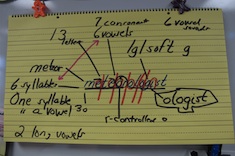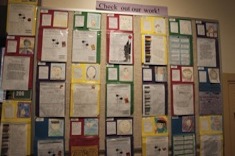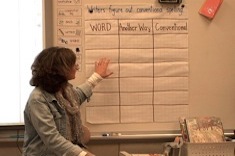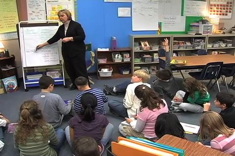Relative location, longitude, scale, prime meridian, cardinal directions.
What do all these terms have in common? These words and several more will be the focus of an upcoming fifth-grade social studies unit. Instead of passing out a list of 23 words, I will assign one word to each student, and the students will become the expert on their word throughout the unit.
Weaving word learning into all subject areas is key to helping students build a solid foundation for determining the meaning of words and then transferring the new words into their writing. Here are two ways I weave word learning into content areas.
Name tags: Since reading Word Savvy by Max Brand, I've always had my students create their own name tag on white index cards during the first few days of school. I have mine made to show them a model of what I expect. I encourage them to use large block letters and decorate the card with their favorite colors and items. When they are finished, they put a magnet on the back and we use these cards for our first word sort of the year when we will be discussing syllables.
For content areas, my students are assigned a new name tag according to the subject. This year in social studies, I created new name tags by folding an index card in half and writing one of the 23 terms that they will need to learn for the new unit. On the first day of class, I have the students choose a card out of the hat, and they write down anything they know about their word. Knowing their background knowledge helps me do formative assessments. For the next few weeks as instruction continues, if their word comes up, they are the expert, and they share what they know in addition to adding new facts to the index card. (See photo.) These cards allow for movement in the classroom. For example the cards might read (legend finds key) (latitude finds longitude) (intermediate finds cardinal). If students are confused about relative location, they go and ask the expert for help. Students choose to go above and beyond, researching their term and drawing pictures to represent it. We call this our living dictionary.
Bury boring words: Several weeks before this activity, we start collecting a list of boring, worn-out words. We collect these boring words as the students share during writing workshop. In October, each student chooses a word they want to bury and writes it on a ghost in chalk. Then on the sun they have to find at least three new words to use instead of the buried word. We hang the cards on the cabinets so the students will have a visual thesaurus to use all year in their writing.
There are several goals that I have when building stronger wordsmiths. Students must
- be able to pronounce the word,
- present a context for understanding the word,
- be able to define the word, and
- apply the word through transferring it to their writing.
We use our evolving new vocabulary in new contexts by
- writing a sentence showing meaning;
- creating an infographic with word, definition, and illustration;
- pantomiming the word for a fun review;
- working with a partner to use two or three words in one sentence; and
- building a class dictionary on large index cards, using a ring to hook them together.
Integration of word work in all content areas is important for students to see that word learning extends beyond a list and the definition. Strong conversations focused on words throughout the school day builds success with word learning, and students enjoy exploring words in multiple ways.









